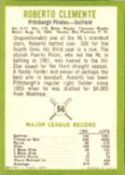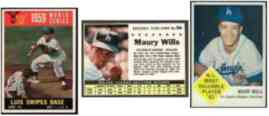1952 Bowman #145 Johnny Mize (Yankees)
| Grade |
VG |
| Book Value |
$ 60 |
| Our Price |
$ 11.95
Add to cart
|


Below are short bits & pieces on sportscard & baseball trading card collecting.
Please wander around the website for more info, prices, values & images
on vintage baseball, football, basketball, hockey, sport and non-sports cards.
1952 Topps Baseball Cards
Checklist & Values
1952 is often thought of as Topps 1st baseball card set, but it was not.
Topps issued several smaller baseball card sets prior to their huge 1952 set.
The buzz word at Topps back then was "BIGGER is BETTER" for their 1952 Topps set
which Topps described as: "GIANT IN BOTH SIZE and NUMBER of CARDS" (407).
Key card in the 1952 Topps set is #311 MICKEY MANTLE.
Often called Mickey Mantle's Rookie card - BUT IT IS NOT. That honor
goes to his 1951 Bowman.
1952 Topps "High Numbers" (#311-#407), are very, very scarce with an
interesting story:
This HUGE set was released in series, released weeks apart. By the last
series, baseball was over and football starting.
??? Perhaps the set was too huge ???
Shops had cards left from earlier in the year so many orders
were cancelled, thus the scarcity.
Adding interest is how Topps got rid of the now useless cards, including
THOUSANDS of MICKEY MANTLE's. They dumped them into the Ocean !!!
|

1955 Topps Double-Headers (Doubleheaders)
Baseball Cards Set checklist/info


Without a doubt my FAVORITE SET - PERIOD. Regular issue, test issues,
inserts ... whatever ... this is # 1 !!!
Similar to the early 1900's Mecca Double Folders, these colorful
2-1/16" x 4-7/8" cards are actually 2-cards-in-1 !
Perforated in the center, you can fold to create cards of 2
different players. Unperforated 1955 Topps DoubleHeaders exist.
 All 132 players (66 cards) in the 1955 Topps DoubleHeaders set were also in
the regular 1955 Topps set, with the same action image.
All 132 players (66 cards) in the 1955 Topps DoubleHeaders set were also in
the regular 1955 Topps set, with the same action image.
 NOTE: Laid side-by-side the cards form spectacular scenes
from actual stadiums !!!
NOTE: Laid side-by-side the cards form spectacular scenes
from actual stadiums !!!
Old-timers - can you identify the stadiums ?
ROOKIES:
Harmon Killebrew, Hal Newhouser
STARS:
Ted Williams, Hank Aaron, Jackie Robinson ...
The Best !!!
Click for complete
1955 Topps Double-Headers (Doubleheaders) baseball cards Checklist and Prices
Note: You may be on that page right now.
|



1963 Fleer Baseball Cards
Checklist & Values
1960 & 1961 Fleer baseball card sets of old-timers
like Babe Ruth bombed. Kids wanted Willie Mays & Mickey Mantle.
Topps had rights to baseball cards & gum so Fleer
tried something new ... COOKIES !!!
Cherry flavored cookies with 1963 baseball cards.

1963 Fleer baseball card set was cut short at 66 cards & checklist
by Topps lawsuit. But what 66 cards! Attractive & packed:
Clemente,Koufax... & 2 very scare Short Prints.

Maury Wills 'rookie' card is a story.
Majors in 1959, quickly superstar. But 1963 for rookie ???
In 1959 Topps deemed Wills NOT WORTHY.

 Wills was upset. After 1962 MVP, Topps came knocking but he said "NO!".
Finally, 1967, Wills first Topps & most costly card.
Note: 1961 Post Cereal card, years BEFORE
Wills was upset. After 1962 MVP, Topps came knocking but he said "NO!".
Finally, 1967, Wills first Topps & most costly card.
Note: 1961 Post Cereal card, years BEFORE
 'official' rookie. He also photo-bombed a 1960 Topps card.
'official' rookie. He also photo-bombed a 1960 Topps card.
Disclaimer: Above mostly true - but Wills has said "no feud".
Note: You may be on that page right now.
|

Tobacco Cards
Starting approximately in 1886, sportscards, mostly baseball cards, were often
included with tobacco products, for promotional purposes and also because the
card reinforced the packaging and protected cigarettes from damage. These sports
cards are referred to as tobacco cards in the baseball card hobby. Over the next
few years many different companies produced baseball cards. Tobacco cards soon
started to disappear as the American Tobacco Company tried to develop a monopoly
by buying out other companies.
They were reintroduced in the 1900s, as American Tobacco came under pressure from
antitrust action and Turkish competition. The most famous and most expensive,
baseball card is the rare T206 Honus Wagner. The card exists in very limited
quantities compared to others of its type because Wagner forced the card to be
removed from printing. It is widely (and incorrectly) believed that Wagner did
so because he refused to promote tobacco, but the true explanation lies in a
dispute over compensation.
Soon other companies also began producing baseball and football cards. Sports magazines
such as The Sporting News were early entries to the market. Candy manufacturers
soon joined the fray and reflected a shift toward a younger target audience for cards.
Caramel companies were particularly active and baseball cards were one of the first
prizes to be included in Cracker Jacks. World War I soon suppressed baseball card
production.








 Without a doubt my FAVORITE SET - PERIOD. Regular issue, test issues,
inserts ... whatever ... this is # 1 !!!
Without a doubt my FAVORITE SET - PERIOD. Regular issue, test issues,
inserts ... whatever ... this is # 1 !!!  All 132 players (66 cards) in the 1955 Topps DoubleHeaders set were also in
the regular 1955 Topps set, with the same action image.
All 132 players (66 cards) in the 1955 Topps DoubleHeaders set were also in
the regular 1955 Topps set, with the same action image.
 NOTE: Laid side-by-side the cards form spectacular scenes
from actual stadiums !!!
NOTE: Laid side-by-side the cards form spectacular scenes
from actual stadiums !!!  1963 Fleer baseball card set was cut short at 66 cards & checklist
by Topps lawsuit. But what 66 cards! Attractive & packed:
Clemente,Koufax... & 2 very scare Short Prints.
1963 Fleer baseball card set was cut short at 66 cards & checklist
by Topps lawsuit. But what 66 cards! Attractive & packed:
Clemente,Koufax... & 2 very scare Short Prints.  Maury Wills 'rookie' card is a story.
Majors in 1959, quickly superstar. But 1963 for rookie ???
In 1959 Topps deemed Wills NOT WORTHY.
Maury Wills 'rookie' card is a story.
Majors in 1959, quickly superstar. But 1963 for rookie ???
In 1959 Topps deemed Wills NOT WORTHY. 
 Wills was upset. After 1962 MVP, Topps came knocking but he said "NO!".
Finally, 1967, Wills first Topps & most costly card.
Note: 1961 Post Cereal card, years BEFORE
Wills was upset. After 1962 MVP, Topps came knocking but he said "NO!".
Finally, 1967, Wills first Topps & most costly card.
Note: 1961 Post Cereal card, years BEFORE
 'official' rookie. He also photo-bombed a 1960 Topps card.
'official' rookie. He also photo-bombed a 1960 Topps card. 